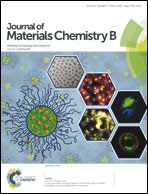Detection of polycyclic aromatic hydrocarbons from cooking oil using ultra-thin layer chromatography and surface enhanced Raman spectroscopy†
Abstract
The combinatory use of on-chip ultra-thin layer chromatography (UTLC) and surface enhanced Raman spectroscopy (SERS) has been demonstrated to detect mixtures of hazardous food contaminants, polycyclic aromatic hydrocarbons (PAHs), from cooking oil samples. After a simple acetonitrile extraction step, the organic phase was directly applied to the chemically modified SERS-active silver nanorod (AgNR) substrate without further cleanup, and subjected to UTLC separation. The spectral interference from co-extracted oil residues was mitigated by UTLC, and the SERS detection limits were found to be equivalent to or lower than those found in standard PAH solutions. The interference from the oil matrix was also quantitatively assessed, and the PAH extraction procedure was optimized for UTLC-SERS. This UTLC-SERS strategy provides a simple but effective method for on-chip sample cleanup and sensing from complex sample matrices.


 Please wait while we load your content...
Please wait while we load your content...